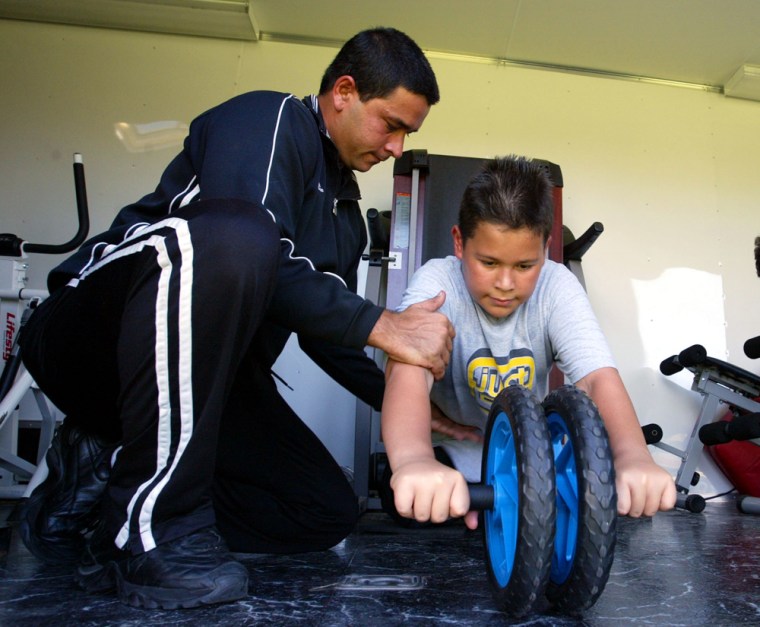Blake Bowers used to belong to a big health club chain, but he quit recently because he felt he just didn't fit in.
For one thing, the adults were always hogging the equipment. But more troublesome were the locker rooms — which were totally gross.
"You go in and there are all these naked guys walking around!" says Bowers, 13, of Mountain View, Calif.
So Bowers, who plays sports and does extra exercise to boost his performance, joined a newly opened gym called Overtime Fitness that's for kids ages 13 to 18 only. He goes two or three days a week after school, does his homework in the gym's study room, equipped with computers, and then exercises. His workouts include climbing the rock wall, doing some fancy footwork on the Dance Dance Revolution machine and hitting the stairclimber, with plenty of socializing with his friends in between.
"It's not like working out," he says. "It's like having fun."
Major plus: No naked old men.
With childhood obesity rates rising and physical education classes declining, gyms have realized there's a fresh new market for them and they are increasingly catering to a younger crowd — with mixed results.
An industry survey released this summer by the IDEA Health and Fitness Association found that 63 percent of club owners and managers said they offered kids' programming, such as hip-hop or other aerobics classes, pint-sized strength machines or sports-oriented personal training.
YMCAs have long had a family-friendly approach to fitness. But now there are gyms that are just for kids, such as Overtime Fitness and Fitwize 4 Kids, a chain with locations in 14 states that offers a circuit program for youngsters ages 6 to 15.
And mainstream chains that traditionally focused on adults have begun opening their doors to youth. Town Sports International, a big chain on the East Coast, lowered its membership age to 14 from 16 a few years ago due to demand, says spokesperson Susan Gerson. "A lot of time parents and kids want to work out together," she says. For younger children, some of the chain's locations also offer specialized programming such as swim lessons, action-oriented birthday parties and tennis lessons.
If you build it, will they come?
But plenty of kids aren't hopping on the gym bandwagon. The IDEA survey, for instance, found that while most clubs offered children's programming, just 9 percent said they had members under 18.
By way of explanation, IDEA executive director Kathie Davis notes that some clubs offer a la carte programming, such as after-school camps or sports clinics, that a child could participate in without actually becoming a full-fledged member. In other cases, parents may be slow to catch on to the new trend or they may be too busy to take their kids, or themselves, to the gym. Beyond that, kids like Bowers may not feel comfortable at some gyms, particularly those designed for adults, or they simply may not be interested in "working out."
Some mainstream clubs aren't drawing in as many kids as they would like because they make the mistake of thinking they can apply the adult fitness model to youngsters, says Debi Pillarella, a personal trainer in Munster, Ind., and a spokesperson on youth fitness for the American Council on Exercise.
"Putting kids on a treadmill for 30 minutes, even if it's pink with purple polka dots, it doesn't work," she says.
If adults get bored at the gym and have trouble finding the inspiration to get there, imagine the challenge of motivating kids, notes Brian Grasso, executive director of the International Youth Conditioning Association.
That's why putting some machines in a corner and designating it the kids' area or offering a couple of yoga or Pilates classes for youngsters isn't the right strategy.
"From a developmental standpoint, that's really inappropriate," Grasso says.
The main motivator, says Grasso and Pillarella, is fun. If kids aren't enjoying the activity, they won't stick with it.
Programming doesn't have to be fancy, but it has to be designed with the fun factor in mind.
Grasso says simply setting up an obstacle course so young kids can run, jump, throw, skip and climb — in other words, play — is one way to get them involved.
Or a gym might have a class with stations, where a child warms up with a few minutes on the bike, then stops to quickly put a puzzle together, then hops on the stair machine to climb Mt. Everest and then plays with props such as balls, jump ropes, hula hoops and bean bags.
But of course, kids don't have to go to a gym to get fit.
"We have to embrace kids and parents being active together," Grasso says.
Exercising in the backyard, playground or park is fun time for the whole family, and it's free. Think Frisbee, baseball or kickball, inline skating, tag and hopscotch.
Pillarella recommends that parents limit TV and video game time, and set an example by getting everyone in the family involved in fitness.
"It's not about just driving your kid and dropping them off at the gym down the street," she says.
Smart Fitness appears every other Tuesday
